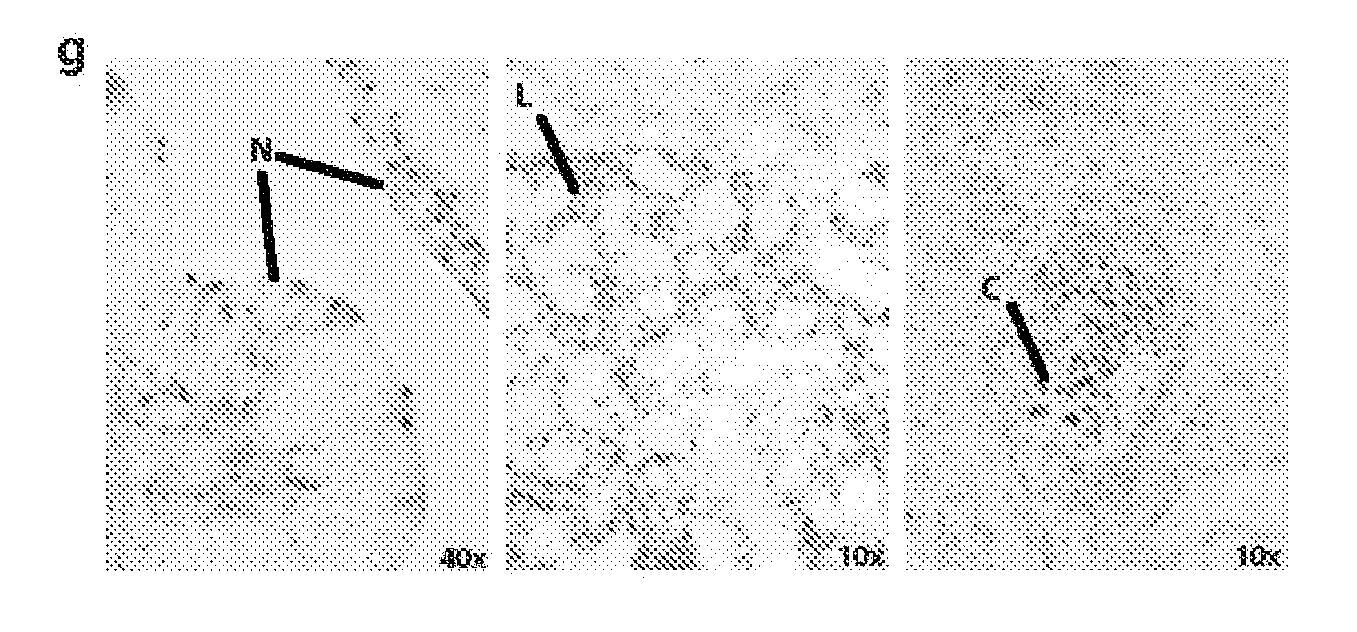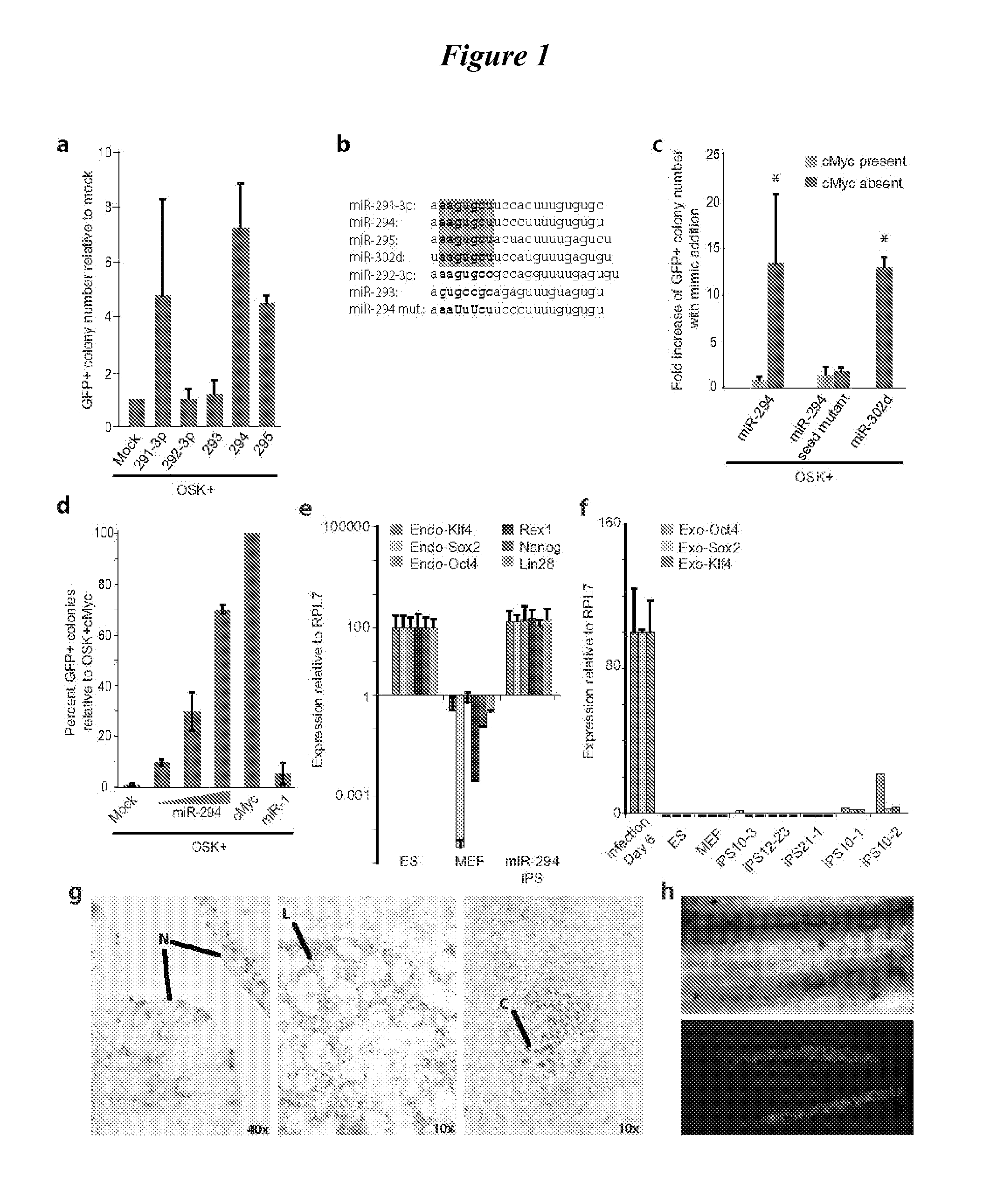Embryonic stem cell specific micrornas promote induced pluripotency
a pluripotent stem and cell specific technology, applied in the field of making induced pluripotent stem cells, can solve the problems of limiting the potential use of escs as therapeutic agents, cell cycle defects, and inability to silence the self-renewal program of escs, and achieves enhanced reprogramming and enhanced klf4. the effect of promoting pluripotency
- Summary
- Abstract
- Description
- Claims
- Application Information
AI Technical Summary
Benefits of technology
Problems solved by technology
Method used
Image
Examples
example 1
Embryonic Stem Cell Specific MicroRNAs Promote Induced Pluripotency
[0092]This work has now been published (see, Judson, R. et al., Nat Biotech 27(5):459-461 (2009) which is incorporated herein by reference in its entirety).
miRNAs Promote Induction of Pluripotency
[0093]The miRNAs miR-291-3p, miR-294, or miR-295 along with retroviruses expressing Oct4, Sox2, and Klf4 (OSK) were introduced into mouse embryonic fibroblasts (MEFs) (See, e.g., Takahashi, K. & Yamanaka, S. Induction of pluripotent stem cells from mouse embryonic and adult fibroblast cultures by defined factors Cell 126:663-676 (2006)). The MEFs carried two reporters: an Oct4-GFP reporter that activates GFP with the induction of pluripotency and ubiquitous expression of a β-galactosidase / neo fusion from the Rosa26 locus. (See, e.g., Blelloch, R., Venere, M., Yen, J. & Ramalho-Santos, M. Generation of induced pluripotent stem cells in the absence of drug selection Cell Stem Cell 1:245-247 (2007)). MiRNAs were introduced on d...
example 2
Let-7 and ESCCS Regulate Self-Renewal
[0110]The let-7 miRNAs are broadly expressed across differentiated tissues (Landgraf, P. et al. Cell 129:1401-1414 (2007); Chen, C. et al. Mamm. Genome 18:316-327 (2007)) and are tightly regulated during ESC differentiation (Rybak, A. et al. Nat Cell Biol 10:987-93 (2008); Viswanathan, S. R. et al., Science 320:97-100 (2008); Heo, I. et al. Mol Cell 32:276-84 (2008 Newman, M. A. et al., RNA 14:1539-49 (2008); Thomson, J. M. et al. Genes Dev 20:2202-7 (2006)). To test the hypothesis that let-7 miRNAs could rescue the capacity of Dgcr8− / − ESCs to silence ESC self-renewal when induced to differentiate, we introduced mimics of a representative let-7 family member, let-7c, into the Dgcr8− / −ESCs (FIG. 10a). Let-7c silenced the ESC self-renewal program even when the ESCs were maintained in ESC culture conditions. Three days after treatment with let-7c, Dgcr8− / − cells downregulated ESC associated markers including alkaline phosphatase activity, Pou5fl / Oc...
example 3
[0139]Additional identified useful ESCC miRNA mimics. Identified during a screen of three factors (Oct4, Sox2, KLF4+ microRNA mimic).
GFP+ Colonies, Normalized to mockmicroRNA mimicexp. 1exp. 2averagemmu-miR-302b11.865.338.6mmu-miR-3021426.720.4mmu-miR-302d8.712.710.7mmu-miR-2943.2169.6mmu-miR-302c2.2148.1mmu-miR-295012.86.4mmu-miR-931.610.86.2mmu-miR-291-3p6.403.2mmu-miR-19a05.22.6mmu-miR-106a04.52.3mmu-miR-2232.90.71.8mmu-miR-291b-3p2.101.1mmu-miR-20b1.100.6mmu-miR-33000
PUM
| Property | Measurement | Unit |
|---|---|---|
| Fraction | aaaaa | aaaaa |
Abstract
Description
Claims
Application Information
 Login to view more
Login to view more - R&D Engineer
- R&D Manager
- IP Professional
- Industry Leading Data Capabilities
- Powerful AI technology
- Patent DNA Extraction
Browse by: Latest US Patents, China's latest patents, Technical Efficacy Thesaurus, Application Domain, Technology Topic.
© 2024 PatSnap. All rights reserved.Legal|Privacy policy|Modern Slavery Act Transparency Statement|Sitemap



